Yu Xia
Towards Generalizable Safety in Crowd Navigation via Conformal Uncertainty Handling
Aug 07, 2025Abstract:Mobile robots navigating in crowds trained using reinforcement learning are known to suffer performance degradation when faced with out-of-distribution scenarios. We propose that by properly accounting for the uncertainties of pedestrians, a robot can learn safe navigation policies that are robust to distribution shifts. Our method augments agent observations with prediction uncertainty estimates generated by adaptive conformal inference, and it uses these estimates to guide the agent's behavior through constrained reinforcement learning. The system helps regulate the agent's actions and enables it to adapt to distribution shifts. In the in-distribution setting, our approach achieves a 96.93% success rate, which is over 8.80% higher than the previous state-of-the-art baselines with over 3.72 times fewer collisions and 2.43 times fewer intrusions into ground-truth human future trajectories. In three out-of-distribution scenarios, our method shows much stronger robustness when facing distribution shifts in velocity variations, policy changes, and transitions from individual to group dynamics. We deploy our method on a real robot, and experiments show that the robot makes safe and robust decisions when interacting with both sparse and dense crowds. Our code and videos are available on https://gen-safe-nav.github.io/.
R4ec: A Reasoning, Reflection, and Refinement Framework for Recommendation Systems
Jul 23, 2025Abstract:Harnessing Large Language Models (LLMs) for recommendation systems has emerged as a prominent avenue, drawing substantial research interest. However, existing approaches primarily involve basic prompt techniques for knowledge acquisition, which resemble System-1 thinking. This makes these methods highly sensitive to errors in the reasoning path, where even a small mistake can lead to an incorrect inference. To this end, in this paper, we propose $R^{4}$ec, a reasoning, reflection and refinement framework that evolves the recommendation system into a weak System-2 model. Specifically, we introduce two models: an actor model that engages in reasoning, and a reflection model that judges these responses and provides valuable feedback. Then the actor model will refine its response based on the feedback, ultimately leading to improved responses. We employ an iterative reflection and refinement process, enabling LLMs to facilitate slow and deliberate System-2-like thinking. Ultimately, the final refined knowledge will be incorporated into a recommendation backbone for prediction. We conduct extensive experiments on Amazon-Book and MovieLens-1M datasets to demonstrate the superiority of $R^{4}$ec. We also deploy $R^{4}$ec on a large scale online advertising platform, showing 2.2\% increase of revenue. Furthermore, we investigate the scaling properties of the actor model and reflection model.
SAND: Boosting LLM Agents with Self-Taught Action Deliberation
Jul 10, 2025Abstract:Large Language Model (LLM) agents are commonly tuned with supervised finetuning on ReAct-style expert trajectories or preference optimization over pairwise rollouts. Most of these methods focus on imitating specific expert behaviors or promoting chosen reasoning thoughts and actions over rejected ones. However, without reasoning and comparing over alternatives actions, LLM agents finetuned with these methods may over-commit towards seemingly plausible but suboptimal actions due to limited action space exploration. To address this, in this paper we propose Self-taught ActioN Deliberation (SAND) framework, enabling LLM agents to explicitly deliberate over candidate actions before committing to one. To tackle the challenges of when and what to deliberate given large action space and step-level action evaluation, we incorporate self-consistency action sampling and execution-guided action critique to help synthesize step-wise action deliberation thoughts using the base model of the LLM agent. In an iterative manner, the deliberation trajectories are then used to finetune the LLM agent itself. Evaluating on two representative interactive agent tasks, SAND achieves an average 20% improvement over initial supervised finetuning and also outperforms state-of-the-art agent tuning approaches.
LPO: Towards Accurate GUI Agent Interaction via Location Preference Optimization
Jun 11, 2025

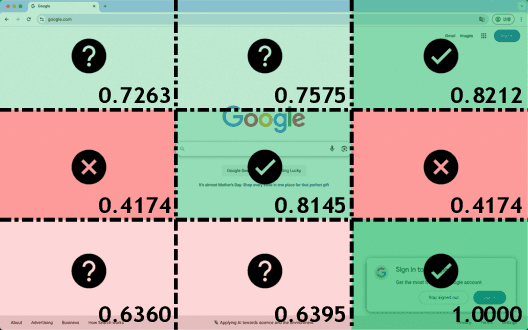
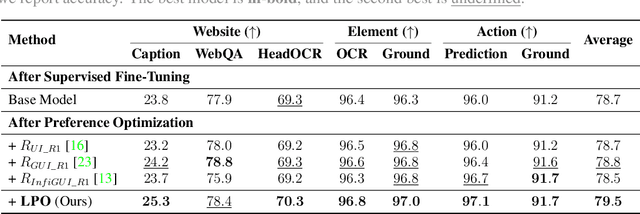
Abstract:The advent of autonomous agents is transforming interactions with Graphical User Interfaces (GUIs) by employing natural language as a powerful intermediary. Despite the predominance of Supervised Fine-Tuning (SFT) methods in current GUI agents for achieving spatial localization, these methods face substantial challenges due to their limited capacity to accurately perceive positional data. Existing strategies, such as reinforcement learning, often fail to assess positional accuracy effectively, thereby restricting their utility. In response, we introduce Location Preference Optimization (LPO), a novel approach that leverages locational data to optimize interaction preferences. LPO uses information entropy to predict interaction positions by focusing on zones rich in information. Besides, it further introduces a dynamic location reward function based on physical distance, reflecting the varying importance of interaction positions. Supported by Group Relative Preference Optimization (GRPO), LPO facilitates an extensive exploration of GUI environments and significantly enhances interaction precision. Comprehensive experiments demonstrate LPO's superior performance, achieving SOTA results across both offline benchmarks and real-world online evaluations. Our code will be made publicly available soon, at https://github.com/AIDC-AI/LPO.
Multimodal Tabular Reasoning with Privileged Structured Information
Jun 04, 2025Abstract:Tabular reasoning involves multi-step information extraction and logical inference over tabular data. While recent advances have leveraged large language models (LLMs) for reasoning over structured tables, such high-quality textual representations are often unavailable in real-world settings, where tables typically appear as images. In this paper, we tackle the task of tabular reasoning from table images, leveraging privileged structured information available during training to enhance multimodal large language models (MLLMs). The key challenges lie in the complexity of accurately aligning structured information with visual representations, and in effectively transferring structured reasoning skills to MLLMs despite the input modality gap. To address these, we introduce TabUlar Reasoning with Bridged infOrmation ({\sc Turbo}), a new framework for multimodal tabular reasoning with privileged structured tables. {\sc Turbo} benefits from a structure-aware reasoning trace generator based on DeepSeek-R1, contributing to high-quality modality-bridged data. On this basis, {\sc Turbo} repeatedly generates and selects the advantageous reasoning paths, further enhancing the model's tabular reasoning ability. Experimental results demonstrate that, with limited ($9$k) data, {\sc Turbo} achieves state-of-the-art performance ($+7.2\%$ vs. previous SOTA) across multiple datasets.
Cross-Task Experiential Learning on LLM-based Multi-Agent Collaboration
May 29, 2025Abstract:Large Language Model-based multi-agent systems (MAS) have shown remarkable progress in solving complex tasks through collaborative reasoning and inter-agent critique. However, existing approaches typically treat each task in isolation, resulting in redundant computations and limited generalization across structurally similar tasks. To address this, we introduce multi-agent cross-task experiential learning (MAEL), a novel framework that endows LLM-driven agents with explicit cross-task learning and experience accumulation. We model the task-solving workflow on a graph-structured multi-agent collaboration network, where agents propagate information and coordinate via explicit connectivity. During the experiential learning phase, we quantify the quality for each step in the task-solving workflow and store the resulting rewards along with the corresponding inputs and outputs into each agent's individual experience pool. During inference, agents retrieve high-reward, task-relevant experiences as few-shot examples to enhance the effectiveness of each reasoning step, thereby enabling more accurate and efficient multi-agent collaboration. Experimental results on diverse datasets demonstrate that MAEL empowers agents to learn from prior task experiences effectively-achieving faster convergence and producing higher-quality solutions on current tasks.
Hierarchical Tree Search-based User Lifelong Behavior Modeling on Large Language Model
May 26, 2025Abstract:Large Language Models (LLMs) have garnered significant attention in Recommendation Systems (RS) due to their extensive world knowledge and robust reasoning capabilities. However, a critical challenge lies in enabling LLMs to effectively comprehend and extract insights from massive user behaviors. Current approaches that directly leverage LLMs for user interest learning face limitations in handling long sequential behaviors, effectively extracting interest, and applying interest in practical scenarios. To address these issues, we propose a Hierarchical Tree Search-based User Lifelong Behavior Modeling framework (HiT-LBM). HiT-LBM integrates Chunked User Behavior Extraction (CUBE) and Hierarchical Tree Search for Interest (HTS) to capture diverse interests and interest evolution of user. CUBE divides user lifelong behaviors into multiple chunks and learns the interest and interest evolution within each chunk in a cascading manner. HTS generates candidate interests through hierarchical expansion and searches for the optimal interest with process rating model to ensure information gain for each behavior chunk. Additionally, we design Temporal-Ware Interest Fusion (TIF) to integrate interests from multiple behavior chunks, constructing a comprehensive representation of user lifelong interests. The representation can be embedded into any recommendation model to enhance performance. Extensive experiments demonstrate the effectiveness of our approach, showing that it surpasses state-of-the-art methods.
CachePrune: Neural-Based Attribution Defense Against Indirect Prompt Injection Attacks
Apr 29, 2025Abstract:Large Language Models (LLMs) are identified as being susceptible to indirect prompt injection attack, where the model undesirably deviates from user-provided instructions by executing tasks injected in the prompt context. This vulnerability stems from LLMs' inability to distinguish between data and instructions within a prompt. In this paper, we propose CachePrune that defends against this attack by identifying and pruning task-triggering neurons from the KV cache of the input prompt context. By pruning such neurons, we encourage the LLM to treat the text spans of input prompt context as only pure data, instead of any indicator of instruction following. These neurons are identified via feature attribution with a loss function induced from an upperbound of the Direct Preference Optimization (DPO) objective. We show that such a loss function enables effective feature attribution with only a few samples. We further improve on the quality of feature attribution, by exploiting an observed triggering effect in instruction following. Our approach does not impose any formatting on the original prompt or introduce extra test-time LLM calls. Experiments show that CachePrune significantly reduces attack success rates without compromising the response quality. Note: This paper aims to defend against indirect prompt injection attacks, with the goal of developing more secure and robust AI systems.
In-context Ranking Preference Optimization
Apr 21, 2025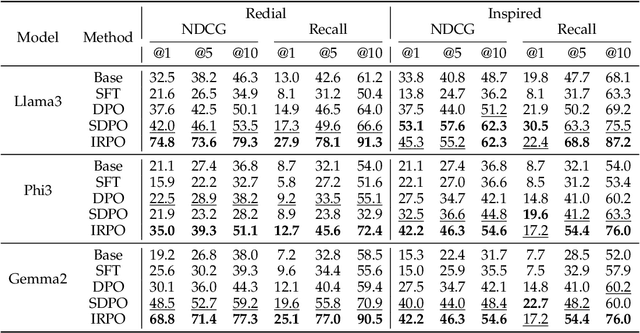
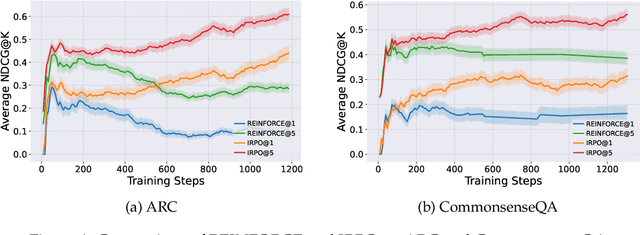
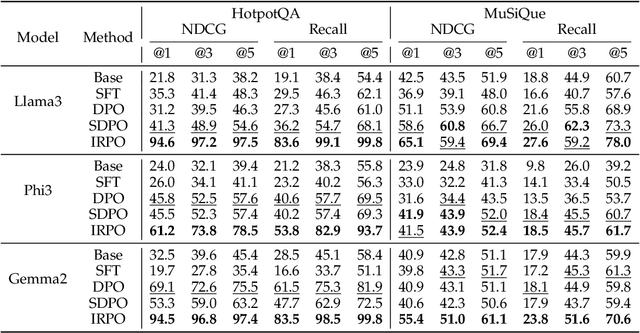
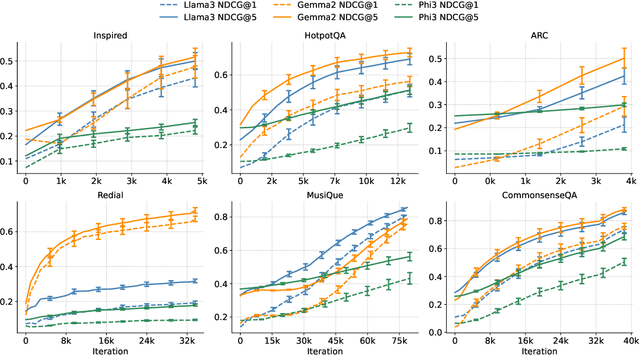
Abstract:Recent developments in Direct Preference Optimization (DPO) allow large language models (LLMs) to function as implicit ranking models by maximizing the margin between preferred and non-preferred responses. In practice, user feedback on such lists typically involves identifying a few relevant items in context rather than providing detailed pairwise comparisons for every possible item pair. Moreover, many complex information retrieval tasks, such as conversational agents and summarization systems, critically depend on ranking the highest-quality outputs at the top, emphasizing the need to support natural and flexible forms of user feedback. To address the challenge of limited and sparse pairwise feedback in the in-context setting, we propose an In-context Ranking Preference Optimization (IRPO) framework that directly optimizes LLMs based on ranking lists constructed during inference. To further capture flexible forms of feedback, IRPO extends the DPO objective by incorporating both the relevance of items and their positions in the list. Modeling these aspects jointly is non-trivial, as ranking metrics are inherently discrete and non-differentiable, making direct optimization difficult. To overcome this, IRPO introduces a differentiable objective based on positional aggregation of pairwise item preferences, enabling effective gradient-based optimization of discrete ranking metrics. We further provide theoretical insights showing that IRPO (i) automatically emphasizes items with greater disagreement between the model and the reference ranking, and (ii) links its gradient to an importance sampling estimator, yielding an unbiased estimator with reduced variance. Empirical results show IRPO outperforms standard DPO approaches in ranking performance, highlighting its effectiveness in aligning LLMs with direct in-context ranking preferences.
From Reviews to Dialogues: Active Synthesis for Zero-Shot LLM-based Conversational Recommender System
Apr 21, 2025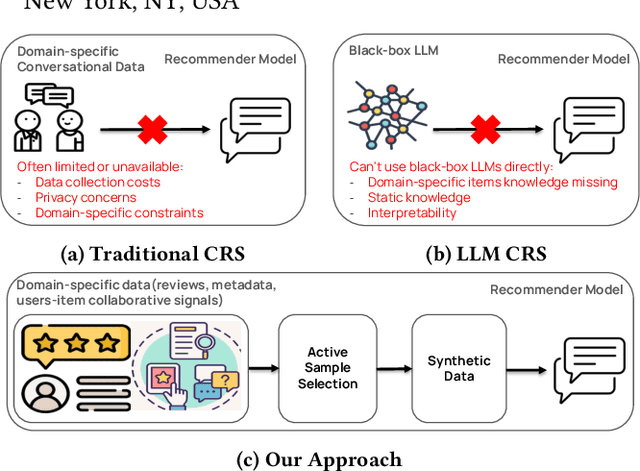
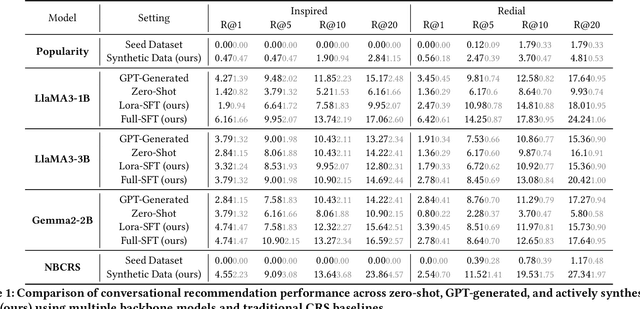

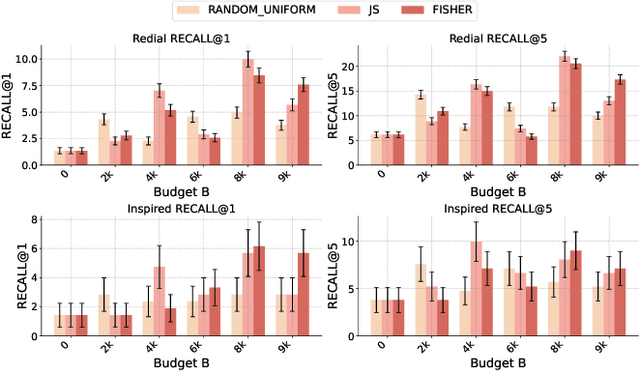
Abstract:Conversational recommender systems (CRS) typically require extensive domain-specific conversational datasets, yet high costs, privacy concerns, and data-collection challenges severely limit their availability. Although Large Language Models (LLMs) demonstrate strong zero-shot recommendation capabilities, practical applications often favor smaller, internally managed recommender models due to scalability, interpretability, and data privacy constraints, especially in sensitive or rapidly evolving domains. However, training these smaller models effectively still demands substantial domain-specific conversational data, which remains challenging to obtain. To address these limitations, we propose an active data augmentation framework that synthesizes conversational training data by leveraging black-box LLMs guided by active learning techniques. Specifically, our method utilizes publicly available non-conversational domain data, including item metadata, user reviews, and collaborative signals, as seed inputs. By employing active learning strategies to select the most informative seed samples, our approach efficiently guides LLMs to generate synthetic, semantically coherent conversational interactions tailored explicitly to the target domain. Extensive experiments validate that conversational data generated by our proposed framework significantly improves the performance of LLM-based CRS models, effectively addressing the challenges of building CRS in no- or low-resource scenarios.
 Add to Chrome
Add to Chrome Add to Firefox
Add to Firefox Add to Edge
Add to Edge